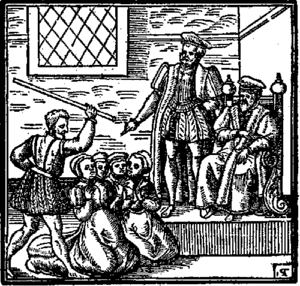Euphame MacCalzean
| Euphame MacCalzean | |
|---|---|
| Died |
25 June 1591 Edinburgh |
| Spouse(s) | Patrick Moscrop |
| Parent(s) |
|
Euphame MacCalzean - also known as Ewphame Mecalrean [1] - (born before 1558, died 25 June 1591 in Edinburgh) was burnt to death as a result of the Scottish witch-hunt, which involved the first British King and it was known as the North Berwick Witch Trials of 1590-1591.[2]
Background
MacCalzean's mother is unknown but her rich father Thomas MacCalzean of Cliftonhall (Lord Cliftonhall) recognised her legally as his daughter and heir in 1558. He was an eminent Edinburgh barrister.[3]
MacCalzean married Patrick Moscrop who served as a Justice depute but the relative power of their families meant that Patrick unusually took her father-in-law's surname of MacCalzean.[3] Euphame and Patrick had at least five children.[2]
North Berwick Witch Trials of 1590-1591
The initial cause of the events that led to the North Berwick Witch Trials was the behaviour of a maid named, Geillis Duncan. Duncan had cured people of illnesses and this caused questions to be asked about how this was possible in November 1590. Her employer had become suspicious that she was deriving her powers from the Devil. Duncan confessed, possibly under duress, to witchcraft and she implicated others including John Cane and Euphame MacCalzean.[4]
Euphame MacCalzean, Agnes Sampson and several other people were accused of witchcraft. Their behaviour was treasonous as it was alleged that they planned to murder the first king of England and Scotland, James VI. James was a king by divine right and he was seen as the chief defender against the devil. James was convinced that magic was involved when Agnes Sampson told him of details of his first night with his wife Anne of Denmark.[4] The prosecutors cast MacCalzean as a controlling personality who used magic to bewitch her husband. She had tried to cause the deaths of her husband, his father and his extended family. The charges included the accusation that she had used her skills to relieve the God ordained pain of women giving birth.[2] Macalzean was said to have caused the death of her cousin and her nephew. She had argued with her uncle over the ownership of some land at Cliftonhall and it was alleged that she had killed his son, her nephew, because of this dispute.[3]
Death
MacCalzean was found guilty and burnt alive in 1591.[2]
References
- ↑ 1566-1625., James I, King of England, (2016). The annotated Daemonologie : a critical edition. Warren, Brett. R,. ISBN 9781532968914. OCLC 1008940058.
- 1 2 3 4 Moir, Scott (2006). Ewan, Elizabeth; Innes, Sue; Reynolds, Sian, eds. The biographical dictionary of Scottish women : from the earliest times to 2004. Edinburgh: Edinburgh University Press. ISBN 9780748626601. OCLC 367680960.
- 1 2 3 Yeoman, Louise (2002-09-21). "Hunting the rich witch in Scotland: high-status witchcraft suspects and their persecutors, 1590-1650". In Goodare, Julian. The Scottish Witch-Hunt in Context. Manchester University Press. p. 107. ISBN 9780719060243.
- 1 2 Burns, William E. (2003). Witch Hunts in Europe and America: An Encyclopedia. Greenwood Publishing Group. ISBN 9780313321429.
